CyberPower's X6-9300 and MSI's GT680R: Fighting for Your Mobile Gaming Dollar
by Jarred Walton on May 13, 2011 10:59 PM EST- Posted in
- Laptops
- Intel
- MSI
- Clevo
- Sandy Bridge
- CyberPowerPC
- NVIDIA
Application Performance, Now with PCMark 7
We’ll start with our usual look at application performance, but we’re making a new addition to the benchmarks. Out goes PCMark05 results (we might still put them in Mobile Bench, but they won’t be in the articles) and in comes PCMark 7 (the seven is for Windows 7, incidentally; though the test runs on Vista as well, results may not be optimal and I’m not sure if you can run the full PCMark suite). Officially launched on May 12, PCMark 7 updates the benchmark suite with a revised set of applications and tests. This goes along nicely with the newly christened 3DMark 11, which we will get to in a minute.
We’re going to break with our mobile testing tradition and run the full suite of PCMark 7 benchmarks. They consist of the following areas: PCMark, Lightweight, Productivity, Creativity, Entertainment, Computation, and Storage. Each individual score represents a composite score for several other tests, and we’ll discuss some of the results in those tests where appropriate. Many have asked for additional application tests, and the various PCMark 7 benchmarks do a good job of running a variety of workloads. If you want to know the specifics of each test, you can consult the PCMark 7 Whitepaper.
With that introduction out of the way, here’s how the P151HM and GT680R stack up to the competition. We’ve used green for the two notebooks we’re focusing on in this review, gold for the Dell XPS 15 L502x, and black for the Clevo P150HM (sporting an i7-2720QM and an HD 6970M). The ASUS G73SW is also highlighted in a lighter blue, though most of the tests will have it running neck and neck with these two notebooks. As with any new benchmark, we don’t have a full set of results for all the older laptops and notebooks in PCMark 7, but we did run it on several other notebooks to provide some reference points. We’ll start there before moving to the rest of our application tests.
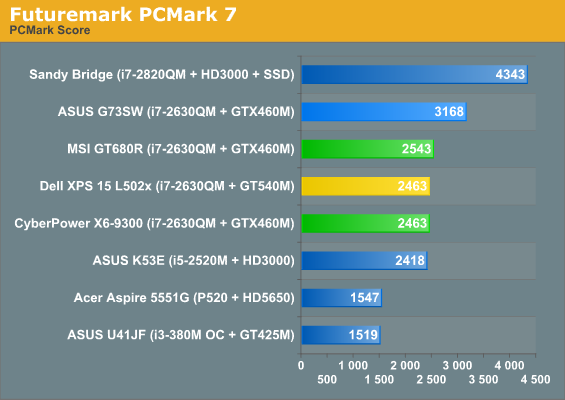
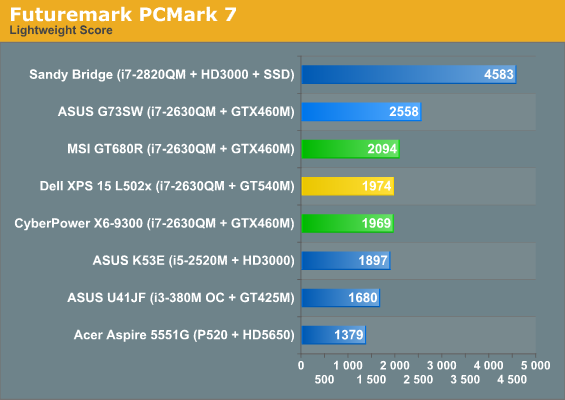
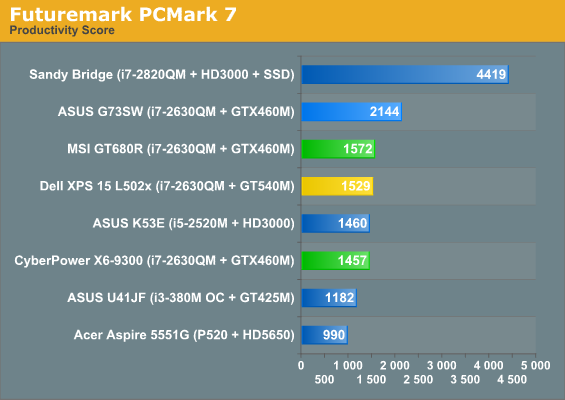
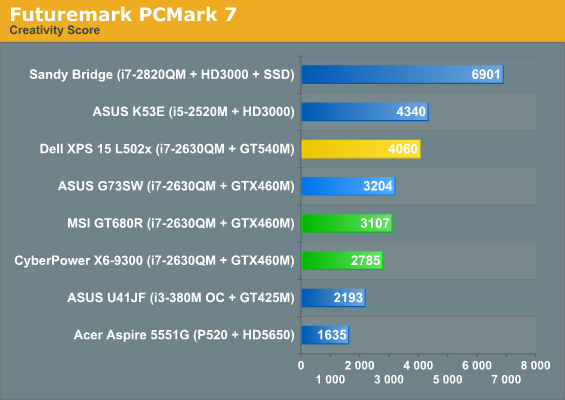
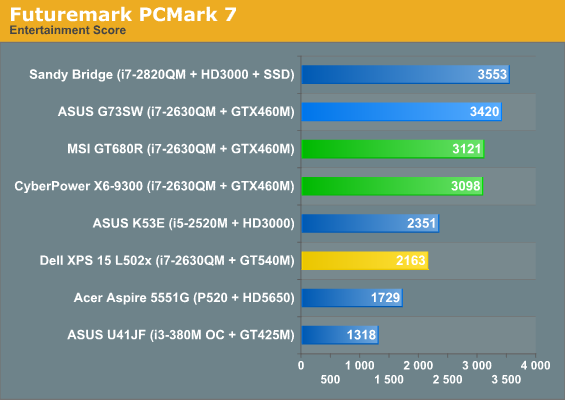
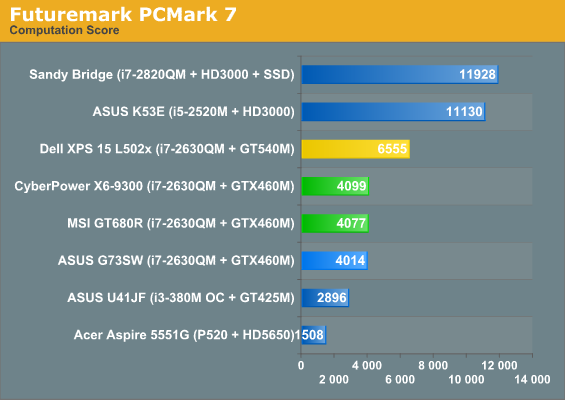
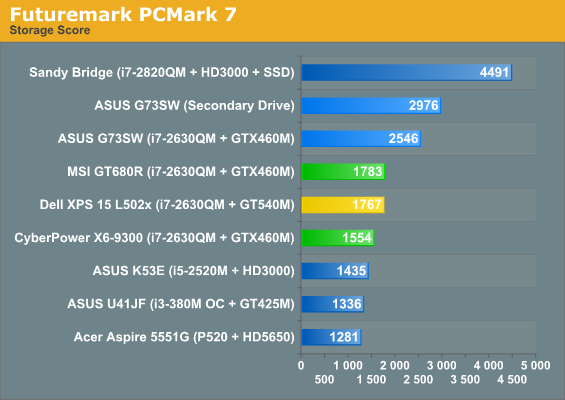
When we first ran PCMark 7, we noticed some oddities: the ASUS G73SW ended up beating the similarly equipped Clevo P151HM, Dell XPS 15 L502x, and MSI GT680R systems by 25%, which is well outside the margin of error we would expect. Looking at the individual test results, we quickly discovered the culprit: the storage subsystem results were around twice as fast on the ASUS compared to the other three laptops. The Dell has a 750GB 7200RPM Western Digital Scorpio Black, whereas the ASUS, Clevo, and MSI notebooks all use the venerable 500GB Seagate Momentus 7200.4; if those three all have the same HDD—heck, the MSI has two of them in RAID 0!—then why are the scores so different?
I decided to pull out the heavy guns on this one and make sure we were playing on a level field; that’s right: I defragged. Actually, I always do that before running benchmarks, but since I had just installed PCMark 7 I thought it was worth a shot. I reran PCMark 7 a couple times to see if some sort of optimization on subsequent runs was coming into play (e.g. SuperFetch). Nope; in fact, the first run on each laptop was usually the highest result out of five runs. After all the testing, I’m still not exactly sure what’s going on. I thought at first that since ASUS has two hard drives, so that might be part of it; however, PCMark 7 let’s you run the storage test on the secondary drive, and I did that as well (and generated an even higher result on the Storage test). A quick look at the ASUS K53E scores shows the same approximate doubling of HDD bandwidth in the various storage subtests, so I have to conclude that ASUS has a BIOS, firmware, or driver optimization that’s giving them a sizeable lead in the PCMark 7 results. Of course, that lead only holds up as long as you’re not looking at the performance of the Sandy Bridge i7-2820QM with an SSD.
In both PCMark 7 and PCMark Vantage (see below), the presence of an SSD definitely makes its presence known. Part of that is because SSDs really do make a system snappier in a lot of ways; the other part of the story is that storage related subtests are in every one of the PCMark 7 suites, with the exception of the Computation benchmark. There’s an interesting element to that test as well, though, in that it has two video transcoding tests, and both appear to use Intel’s Quick Sync when it’s available. The result is that the dual-core and quad-core Sandy Bridge laptops with no discrete graphics come out looking like a champ in that discipline—and they really are fast on video transcoding with the right application. We could force the Dell laptop to run only on the IGP, but interestingly it appears that Quick Sync is only partially used with Optimus. Anyway, don’t get too caught up in the charts, because the large differences in the storage related tests really skew the results.










44 Comments
View All Comments
JarredWalton - Saturday, May 14, 2011 - link
Yeah, the price is the big sticking point, plus I'd still rather have a GeForce 460M + Optimus instead of the Quadro 2000M. I'm not sure why NVIDIA doesn't use GDDR5 for the Quadro 2000M, since that's the only major bottleneck it has. Maybe VRAM bandwidth isn't that critical for Quadro's normal use cases?chrnochime - Saturday, May 14, 2011 - link
You can't have everything on your laundry list of requirements and still want them to charge the same amount of money as these ones you're offering. Pony up the money or put up with the compromises.chrnochime - Saturday, May 14, 2011 - link
Dammit I mean "these ones you're reviewing."JarredWalton - Saturday, May 14, 2011 - link
Take the P151HM, which you can get as configured for about $1300. Now add in Optimus and spend $200 improving the keyboard and chassis. Are you saying that's not possible? Because $200 would go a long way towards fixing the few complaints I had with that design -- I figure $50 for a new keyboard layout with backlighting, and the remaining $150 can be put towards a magnesium alloy chassis. Add in maybe $25 extra to do Optimus (there's no additional hardware required, just enable the feature in the BIOS AFAIK) and you'd have my $1500 "dream" laptop.The fact that Lenovo's W520 can be purchased on sale for $1500 with nearly everything in my list proves it can be done--and Lenovo would still make money if they sold every W520 at that price, but they want to make more money.
DanNeely - Saturday, May 14, 2011 - link
I heard about them a few years ago with the 1st generation MSI wind netbooks. The reason they have the retarded tap the corner to scroll instead of the more common swipe the edge behavior is that Synaptics has a patent on the latter. I don't know if they refuse to license it or if Sentelic is just too cheap; although the fact that Synaptic has a stranglehold on the touchpad market makes me suspect the former.yyrkoon - Saturday, May 14, 2011 - link
Jarred, I am very glad you seemed to take to heart one of the points I made in my last bitch session of a laptop review. Well, at least you seemed to mirror one of my beliefs( in text ).Still, I think you would do very well, to educate your readers further. At first, I thought about Anand's comprehensive SSD write up in this context, but I am not sure how that might work in this case. On another semi related point. I still see no mention of driver support. This is very important.
Passed that, I think most readers understand how you feel about certain aspect of different laptops. Personally though, I would rather not read two or more sentences about how you feel about black glossy plastic. In my case, it is a waste of your time to elaborate any further passed " it has a black glossy shell" or whatever. I do not like black glossy plastic either. but guess what ? My own personal laptop is gloss black . . . We never get exactly what we want.
A companies case build policies to me, is something you should be taking up with them, and not us. Not to mention that this kind of "thought" in a review can be construed as being biased against the company. Whether truly fact, or not. Now, if the case felt flimsy, or like the screen might snap off in a short period of time of use . . .then sure thats something we should know.
I can say that my personal use case for a laptop is completely different from yours most of the time. Which in of its self is something to consider. For you, and myself both. This is to say, several of the things that are important to you, are not important to me. Maybe there is some way to format different aspects in a way, where readers can easily take notice, and just skip altogether ? Just a thought. E.g. keyboard, and trackpad functionality are nearly irrelevant. For me, if they work, that is good enough. If I need to do any serious typing, or have need for accurate cursor placement, I *will* use external input devices. No mater where I am, or where I am going with my laptop.
Anyhow, I felt like this was a decent review, although I care about neither product. I have always liked your reviews Jarred, because for the most part I feel when you review a product you are mostly thorough. Take my niggles for what they're worth, but do please seriously consider adding in driver support/stability comments. I am sure many readers of yours would appreciate that.
JarredWalton - Saturday, May 14, 2011 - link
Driver support is generally fine on any NVIDIA, AMD, or Intel graphics card these days. The reference drivers from all three companies work with the vast majority of notebooks. If there's a problem (e.g. Toshiba opting out of AMD's mobile driver program), I'll make a note of it, but otherwise I haven't seen anything with respect to drivers that concerns me. Granted, if you want to be able to go to, say, MSI and grab all the latest drivers, that might be a bigger problem. I usually go directly to the component manufacturer, so NVIDIA, AMD, Intel, Realtek, etc. sites are where I check. Not sure if that answers your question -- is there something specific you want me to comment on? Stability, incidentally, was top notch on both notebooks, with no crashes or unexpected reboots.bhima - Saturday, May 14, 2011 - link
Well balanced review overall. I decided to pick up a clevo based laptop as well, but one with Optimus. The main reason I picked a clevo over the Dell was because I could configure the clevo with a 96% RGB color gamut matte screen (the exact same one that is offered as an upgrade to the W series ThinkPads). Dell glossy screens have a habit of being really "glossy" and I just can't take it anymore. Just like glossy plastic is going out of style, I hope glossy screens for laptops do as well.Hrel - Sunday, May 15, 2011 - link
I agree with your summation. The Clevo seems like the best of the offerings but has flaws I don't want to live with. I really really wish you could get the G53SW in for review, as as long as the screen is good I'd take it. I agree with your wish for a laptop that doesn't exist too; except I don't care much about the speakers. I'd rather the price not get over 1200 than have uber speakers inside my laptop. If I really care I'll use headsets or external speakers or Logitech's clip on speaker. I could live with the 555M GPU as well, as long as it doesn't cost more than 1200. Laptop guys, DO NOT include Blu Ray; that's literally worth nothing to me. Discs are so last decade.Since I'm wishing, Asus, or whoever, put your chassis on cyberpower.com as a whitebox or at the very least with the option to not include the OS. I have my own thanks.
Hrel - Sunday, May 15, 2011 - link
Id like to see a review of the gt540 1080p laptop cyberpower has now.